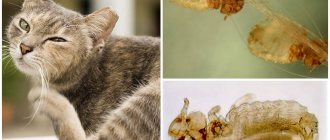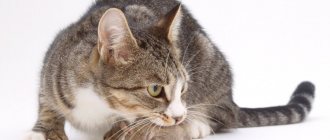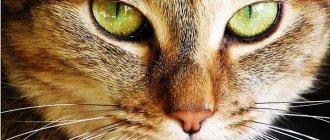A cat, like any animal, like people, is susceptible to the negative influence of external factors - cold and weakened immunity, poor nutrition. As a result of a confluence of unfavorable factors, a cat may catch a cold and the question naturally arises - how to treat a cat for a cold, can this be done at home or should you definitely take the animal to a veterinary hospital for a while? Colds in cats, symptoms and treatment, complications from ARVI - this will be discussed further.
Causes of a cold in a cat
Speaking about how exactly a cat can catch a cold, there are negative factors that have a negative impact, the root causes, and veterinarians include:
- failure in the animal’s diet – if the cat’s diet is balanced and complete, then its health is excellent. If it contains enough vitamins, macro and microelements, then most animals manage to avoid colds.
- infections – they are the ones that negatively affect the immune system, weakening the body’s defenses. As a result, the owners will have to treat the cat for colds, strengthening its immunity with the help of enhanced nutrition and immunostimulants.
- unfavorable living conditions for the animal - a damp and poorly ventilated room, or, conversely, with constant drafts, insufficient, dim lighting and heating, lead to the fact that the cat weakens, its immunity does not resist microbes and the cat’s body corresponds to the negative influence of pathogenic microflora.
The optimal keeping conditions for a cat is a room temperature of 20-23 degrees - this is what should be taken into account when keeping an animal, especially during spring and autumn, when it is cold outside and the central heating in the house has not yet been connected or has already been turned off. Equip your cat with a warm bed, a house, and if your pet’s breed is hairless, such as the Sphynx, then it is best to dress it in clothes. It can be like old things that your children grew out of, dated or specially sewn for them - it all depends on the owners themselves.
Unfavorable external conditions for an animal include wind and draft, rain and snow, and high levels of humidity negatively affect a cat if it is kept outdoors. It also adversely affects the health of the animal, provoking the development of colds and drafts, hypothermia during a walk. That is why you should not walk your pet outside for a long time during the cold autumn and winter months of the year, especially when it is raining or severe frosts outside.
Causes of the disease
New pet owners sometimes wonder: can a cat catch a cold? If some unfavorable factors coincide, this is very possible.
Most often, colds appear after hypothermia. Walking outside in bad weather (rain or snow, frost or strong wind) can also trigger a cold. The pet may be at home in a draft or, after active games, go into a room where the air is too cool.
Some owners wash their cats and do not pay attention to the water temperature. If it is cold, this will lead to hypothermia of the pet. And after bathing, the animal is generally very sensitive to the ambient temperature.
- I'm sick again!..
The body's resistance to various diseases depends on immunity. It may be weak due to poor nutrition or chronic diseases. A weakened and exhausted animal does not have the internal resources to suppress a cold.
Wool protects against small temperature changes. Hairless cat breeds, commonly known as hairless, are even more sensitive to changes in the environment.
Can a cat catch a cold from a person?
Many can - but can a cat catch a cold from a person if its owner or one of the family members is more likely to do so? As veterinarians themselves note, the issue is very controversial. The thing is that a cold is a viral disease, and unless it is a new type of virus, it cannot be contracted from a person. A human ARVI is simply not dangerous for her, but if a cold is caused by bacteria caused by dampness, mold or fungi, then we can talk about the development of a cold in a cat. In cats, treatment in this case will be aimed at a cold caused by fungi. Hypothetically speaking, owners can infect an animal with a cold if their own disease is caused by a bacterial outbreak.
Pathogens of upper respiratory tract infections
In quite rare cases, diseases in cats are caused by the action of only one pathogen: much more often, these pathologies are a consequence of the combined action of viruses and bacteria. Here is a short list of pathogenic microorganisms that most often cause inflammatory processes in the upper respiratory tract of animals:
- Feline herpes virus (FHV-1) , which causes rhinotracheitis (FVR). This is a serious disease, accompanied by a severe cough, and in the presence of secondary bacterial microflora, it can lead to the development of pneumonia. This type of cold is especially severe in kittens: in some cases, the probability of death exceeds 49-60%.
- Feline calcivirosis (FVC).
- Bordetella bronchiseptica (B. bronchiseptica).
- Chlamydia (C. felis). This disease is especially insidious, as it often occurs in an asymptomatic form, appearing only under the influence of stress and other factors leading to a weakened immune system. Moreover, many types of chlamydia found in cats are equally dangerous to humans (children and pregnant women are especially susceptible to infection).
Of course, the reasons are much more varied. Thus, somewhat less frequently, “colds” are caused by the action of mycoplasmas, as well as feline retroviruses. The latter themselves rarely cause inflammation of the upper respiratory tract, but their action leads to a very serious weakening of the immune system, as a result of which the disease is complicated by the action of secondary bacterial microflora.
Let us note that all causative agents of colds in cats are extremely contagious and are released into the external environment in incredible quantities.
In this regard, discharge from the nose, eyes and mouth of sick animals is very “productive”. Thus, any animal can easily become infected simply by being in the same room. The disease is even more likely after direct contact between pets and each other. If a cat’s body already has one of the representatives of retroviruses, it becomes especially susceptible to the action of pathogenic microorganisms.
Many veterinarians today assume that even clinical recovery does not guarantee latent carriage, when the pathogen is still present in the animal’s body. This is especially dangerous in the case of pregnant cats .
- Firstly, pregnancy is a strong stress for the body of the expectant mother, and therefore it may well provoke clinical manifestations of the disease. This will not end well for the unborn kittens.
- Secondly, the likelihood of intrauterine infection is very high. Even if the offspring is born healthy, the babies will inevitably become infected at the very first meal, since many causative agents of cold pathologies can be released into the external environment along with milk.
Carriage of infection
As we have said many times, there is a high risk that your pet, who seems to have recovered from the disease, will continue to release the pathogen into the external environment after recovery, remaining dangerous for clinically healthy animals. Please note that the very fact of carriage is dangerous not only for your pet’s relatives, but also for him. If the pathogen continues to remain in his body, relapse of the disease, unfortunately, is only a matter of the near future.
It is believed that with calcivirosis, approximately half of all recovered animals are lifelong carriers of the pathogen. Fortunately, recent studies have proven that lifelong carriage develops in extremely rare cases and only when the animal has some extremely serious problems with the immune system. In ordinary situations, its period does not exceed six months (which, however, is also a lot).
So curing a cat from a cold is only half the battle. It is equally important to make sure (with the help of clinical studies) that there are no more infectious agents left in your pet’s body.
What complications can a cold cause in a cat?
Many owners mistakenly believe that the disease can go away on its own - the cat has a cold, so what? Everything will go away on its own, but in the absence of timely treatment and measures, even the most minor cold can lead to the development of quite serious complications. This could be pneumonia, kidney failure, or inflammation of the joints.
As a consequence of a cold, the animal’s immune defenses are reduced and it is unable to withstand even minor influences of pathogenic microflora, bacteria and viruses. The cat will often be susceptible to colds and, as a result, this can cause the development of severe pathological changes in its body, often irreversible, even death.
How to treat a cat for a cold: helping a cat at home
If the disease progresses calmly, the pet can be treated at home. Therapy involves comprehensive relief of symptoms, alleviation of the general condition and stopping the progression of the infection. Before treating a cold with medication, follow these steps and monitor your pet for 12 to 24 hours.
- Place the animal in a dry, ventilated area.
- Provide your cat with a warm drink, preferably milk.
- If the animal is cold, cover it and make a heating pad.
- Give the animal a massage from the limbs to the body; if the cat does not like such procedures, just pet it - this will increase blood flow and help the body fight.
“Home” symptomatic treatment is allowed at the stage of a runny nose and increased lacrimation; the cat must be helped to clear the airways, for this:
- We clean the nose and eyes of secretions with a moistened cotton sponge. Wet the sponge in clean water; do not use herbal infusions unless you are sure that your pet is not allergic.
- We rinse the nose with the solution, choose one of the options: Adrenaline novocaine 1%;
- Tannin 0.5%;
- Ethacridine 0.2%;
- Zinc sulfate 2%.
- We instill the nose with a special veterinary medicine or a mixture of fish oil and methanol 1%.
- We try to place streptocide powder in the nostrils, but the cat really doesn’t like it.
If the condition worsens and a cough appears, antibiotics for cats for colds are relevant. If you are not a doctor, it’s better to decide what to treat after consulting a doctor. If you don’t have the opportunity to go to the clinic, call, but don’t make a random choice, especially don’t treat the animal with your own medications.
As a rule, the main and probably the main reason for the development of colds in animals is hypothermia. As a result of exposure of a cat's body to low temperatures, its general condition changes.
The severity of these changes depends on the degree and duration of exposure to cold on the pet, as well as on the degree of perfection of the natural thermoregulation mechanism responsible for the production of heat in the body.
Most often, severely weakened, overtired, exhausted animals, as well as those that have suffered heavy bleeding, serious illnesses, etc., suffer from colds.
Various factors affecting the animal’s body can lead to a cold in cats. These factors include:
- Violation of feeding regime. Proper and nutritious feeding is the key to excellent cat health. If the feed contains a sufficient amount of vitamins, minerals and essential nutrients. then the pet will be able to avoid most cat diseases.
- Infectious diseases lead to a decrease in the body’s protective functions and a weakening of the immune response to the introduction of opportunistic microorganisms.
- Unfavorable living conditions - keeping a cat in a damp, poorly heated room causes colds and accompanying pathological changes in the body. So, a comfortable temperature in a room for a cat during the cold season is considered to be no lower than 20-22 0 C. This fact must be taken into account in the off-season, when there is no heating in the apartments, and provide the animal with a warm bed, for example, near a heating device. It is better to use a flannel diaper or a warm blanket as bedding, which will help the cat warm up and keep its health in perfect condition.
- Unfavorable environmental conditions - sharp wind, rainy or snowy weather, high humidity increase the harmful effects of low temperature on the cat's body when it is outdoors.
- Prolonged stay of a wet animal in a draft. A cat can get into a draft immediately after taking a bath. Therefore, a bathed pet must be thoroughly dried with a terry towel, which absorbs water well, and sent to dry in a warm room with the windows closed.
- Hypothermia of an animal during a walk in the fresh air in the cold season. To avoid these problems, it is better to walk the cat, if this is the practice of the owners, in autumn and winter, in a dosed manner and for a short period of time.
We suggest you read: Sores (scabs) in a cat - causes, symptoms, treatment
A cold in all warm-blooded animals, including cats, is preceded by a compensatory reaction. But the longer the cold lasts, the more the thermoregulation mechanisms are disrupted. As a result, hypothermia occurs, body temperature decreases, and the functions of some body systems are disrupted.
It would seem that, at first glance, such a mild illness in a cat as a cold, in the absence of therapeutic measures, quite often leads to the development of other more severe conditions: inflammation of the lungs and bronchi, the development of kidney disease, and inflammatory diseases in the joints.
As a result of a cold, cats' immunity decreases and the body's natural resistance to infectious diseases decreases.
If in an animal with a good immune system, contact with any microbe or virus will not cause serious health problems and will go almost unnoticed, then in a cat with frequent colds, the same microorganism will cause a severe pathological process.
Signs
As mentioned at the beginning of the article, the main signs of a cold in cats are:
- runny nose,
- hot and dry nose,
- lacrimation,
- slight increase in temperature,
- sneezing,
- fast fatiguability,
- lethargy,
- lack of appetite or decreased appetite.
If these signs are detected, a loving cat owner should not hope for the pet to recover on its own. First of all, a person must make sure that it is really a cold and not some other viral or bacterial disease with similar symptoms or an allergy.
But even with confidence in the etiology of the disease, a cold must be treated with complete seriousness and responsibility, so that it does not develop into another more serious form.
How to treat
When treating a cold, you must first take the following general measures:
- provide your pet with peace and quiet;
- place the cat in a warm, well-heated and dry room;
- provide the animal with a warm drink, for example, regular warmed milk;
- you can use warming compresses or heating pads (the easiest way is to use self-heating saline);
- When there is no heating in the apartment, the most common heaters are used to maintain a comfortable temperature in the room. The main thing is to ensure that the animal does not get burned if it accidentally comes into contact with the hot surface of the heater. It is better to place the heater in a place inaccessible to the cat so that it cannot reach it;
- A regular massage gives a good effect for colds; it is enough to stretch the animal’s body well. As a result of these manipulations, blood flow in the superficial vessels of the skin will increase, the cat will warm up faster after cooling, and the healing process itself will go much faster.
Symptomatic treatment is used as general therapy. If there is a runny nose or discharge from the eyes, special drops are used.
If the process is aggravated by cough and other cold symptoms, it is advisable to prescribe antibiotic therapy to suppress the growth of pathogenic microflora and stop the further development of inflammatory processes.
Symptoms of a cold in an animal
Before starting treatment at home, it is worth distinguishing a cold in an animal from other diseases. First of all, a characteristic sign of a cold in an animal is a hot and dry nose, deterioration in the appearance of the coat, and the cat refuses to play. Also, cold symptoms in cats will manifest themselves in the form of prolonged sleep, attacks of aggression and weakness, and rapid fatigue.
In addition, a cold in an animal will manifest itself with the following symptoms:
- any discharge from the nasal passages, when all dead bacteria and microbes are removed from the body with snot, leukocytes, often yellow, purulent, which will completely close the respiratory and nasal passages. In this case, the animal will breathe through its mouth - a rather dangerous symptom indicating the development of a cold.
- attacks of sneezing and coughing are a natural way and process of cleansing the respiratory system and all nasal passages of the animal. But if sneezing and coughing are not one-time, but constant, then this directly indicates the development of a cold.
- lacrimation is another symptom that is diagnosed when a cat has a cold and is a consequence of irritation of the mucous membrane of the cat's passages.
- the cat’s appetite disappears or decreases - when the animal has a cold, most likely, it will refuse to eat. But the cat will drink water, and sometimes even more than it drank before. You should not force feed your pet - as an option, offer him a rich and nutritious broth. If the refusal to eat lasts more than 2 days, it is urgent to show the animal to a veterinarian.
- increase in cat's body temperature. In this case, it is worth remembering that cats, as a rule, have an unstable body temperature and throughout the day it can change up or down, within 0.5-1 degrees.
It is with this feature in mind that basal temperature can range from 37.5 – 39 degrees in normal health. But if the temperature is more than 40 and lasts more than a day, you should immediately contact a veterinarian.
“If you have diagnosed one or more symptoms in your pet, this is already a reason to show the animal to the veterinarian, because the sooner the disease is diagnosed and treatment is started, the faster the cat will recover.”
Treating cat colds with medications
It is not recommended to treat a cat for a cold on your own without first consulting a specialist. If the body is slightly damaged, the veterinarian writes out a treatment regimen and sends the animal home for treatment.
In more dangerous and advanced cases, hospital treatment is required under the close supervision of specialists. Treatment of colds in cats consists of several basic rules. The main task of the veterinarian is to find out the underlying factor and direct efforts to eliminate it. As a rule, colds are caused by pathogenic bacteria, so treatment is based on antibiotic therapy.
The cat owner must provide the pet with the correct living conditions. The animal must be kept warm and air humidity must be within normal limits. It is also important to give your cat soft and warm food, and to ensure that she has free access to clean drinking water.
If the cold was caused by a viral infection, there are no special cures for viruses. In this case, you need to pay attention to the general strengthening of the body, and in particular the immune system. Only with adequate reactivity of the body is it able to cope independently with any infections.
Antibiotics for cats with colds are prescribed only when there is clearly a risk of pathogenic bacterial microflora joining. The veterinarian selects medications individually and with great care. The following antibiotics are widely used in veterinary medicine in the treatment of colds with the addition of bacteria - Oxytetracycline, Amoxicillin, Gentamicin, Levomycetin.
The amount of the drug and the course of treatment are determined by the doctor individually based on the characteristics. The general condition of the animal, its weight and age must be taken into account.
The total duration of therapy ranges from 5 to 14 days. If the main signs of a cold disappear a few days after the start of treatment, you cannot stop and independently stop the therapy prescribed by a specialist. Otherwise, the infectious lesion from the acute stage will turn into a chronic form.
Treatment at home involves organizing proper care for the animal. It is imperative to rinse the nasal passages from accumulated mucus. This will make it easier for your pet to breathe. For washing, solutions of zinc sulfate, boric acid or tannin solution are used. Medicines are administered for rinsing carefully and slowly from a syringe with a previously removed needle.
Medicines intended to treat human colds are used in cats, but with great caution. You can use vasoconstrictor drops, such as Nazivin, to facilitate nasal breathing. But antipyretic drugs containing paracetamol or aspirin have a negative effect on some internal organs of the cat, causing intoxication and leading to death.
It is also important to understand that it is difficult to independently calculate the correct dose of a human drug in relation to a cat.
How can you cure a cold in a cat?
When considering the question of how to treat colds in cats, at the very beginning it is recommended to show the animal to a veterinarian, who will conduct an examination, make an accurate diagnosis and prescribe certain medications and procedures. But during the treatment process, the owners themselves can take certain measures that will alleviate their pet’s condition and speed up the healing process itself.
With regard to therapeutic measures, the owners should take the following measures that will alleviate the pet’s condition and speed up the healing process itself.
- For a certain time, leave the cat in peace and quiet, especially if there are children in the house - protect the animal from their encroachments and games with it.
- place the animal in a warm place in the house or apartment, always in a dry room - near a radiator or heater, while avoiding the formation of drafts in the room. If the room is not warm enough and there is no heater at hand, warm the animal with a heating pad or warm fur bedding.
- The cat should always have access to warm drink - it can be plain water, but preferably milk.
- A simple massage also gives a good therapeutic effect - just lightly massage and knead the animal’s body. Such manipulations allow you to increase blood flow in the cat’s body, and the animal will warm up faster, and the healing process will speed up.
- if the cat is classified as a hairless breed, so to speak, bald, then it is worthwhile to additionally dress it. For this, the usual warm things that your children have grown out of are suitable - warm overalls, rompers and vests, sweaters.
What dangerous diseases are disguised as signs of a cold?
There are many diseases whose symptoms may resemble a common runny nose. For this reason, it is important for owners to make sure that these ailments are absent. Inflammation of the lungs can be detected by listening to the chest, and if prescribed, you will have to go for an x-ray. Mycoplasmosis and other infections that affect the mucous membranes and genitourinary system may occur.
Calcivirosis is an acute infectious disease that causes ulcers in the mouth. Symptoms may indicate the occurrence of distemper; the disease is dangerous and involves purulent discharge from the nasal cavity.
Only a doctor can definitely say what exactly your pet is sick with. To exclude the possibility of rhinotracheitis, mycoplasmosis, infectious peritonitis, and other infections, you will need to undergo tests and be examined by a veterinarian. Many diseases can be quickly and successfully treated if therapy is started in the early stages.
Drug course of treatment
As for what medications to treat a cat with, they must be prescribed by the veterinarian himself, after examining and examining the pet. So, in each specific case, the course of treatment includes the following measures:
- course of symptomatic treatment. In this case, doctors most often prescribe drops or special solutions to the animal to cleanse the nasal passages of mucous secretions and dried crusts that have formed. Such preparations can be a 0.5% solution of tannin or zinc sulfate 2% strength, boric acid 3%.
- doctors prescribe a course of antibiotics - they allow you to stop and suppress the very process of growth and development of pathogenic bacteria and fungi that affect the respiratory system.
- A course of taking immunomodulators is also indicated - this strengthens the animal’s immunity and helps speed up the healing process itself.
Also, during the general course of therapy, the use of runny nose and lacrimation with the help of special drops is indicated. In any case, all actions and course of treatment, medications should be coordinated with a veterinarian.
Possible complications after a cold
Against the background of a lingering cold, a cat may develop dysfunction of internal organs and systems. If you do not start timely treatment, the disease will affect the lungs and bronchi in a short period of time. The animal's immune system will be reduced. Among the main complications that can occur with a cold are:
- pneumonia is a pathology accompanied by damage to lung tissue. Pneumonia often causes the death of a cat. The cat will cough a lot for the first few days;
- bronchitis is a disease in which the mucous membrane of the bronchi becomes inflamed. The cat suffers from a severe cough, which produces thick sputum and causes breathing problems;
- bacterial arthritis, in which the pet suffers from severe pain and decreased joint mobility;
- pyelonephritis is an inflammatory process in the kidney area, which causes a disruption in the process of urine production. The body is poisoned by metabolic products.










